Ground Deformation Detection Using China’s ZY-3 Stereo Imagery in an Opencast Mining Area
Abstract
:1. Introduction
2. Study Area and Data
2.1. Study Area
2.2. Data
3. Method
3.1. DSM Derived from ZY-3 Stereo Images
Fy = b0 + b1·sample + b2·line + line − y = 0
3.2. Detection and Extraction of Deformation
If ΔHi,j ≤ δ↓, then, (i, j) is the descending area.
4. Results
4.1. DSM Results and Regional Overall Deformation
4.2. Typical Region Deformation
4.3. Topographical Profile Deformation
5. Discussion
5.1. Deformation Status in the Study Area
5.2. Uncertainty of Extracted Deformation
5.3. Accuracy Assessment of DSMs
6. Conclusions
- (1)
- Deformations in the mining area are complicated for its opencast operational activities. Districts with rising and descending elevations couple together in the active mining area. Deformations, such as landslides, not only occurred in the pit wall but also expanded to the pit outside of the case study. The large deformation around the south slope in the west open-pit mine is a representative example. It means that the ground deformation caused by mining activities has expanded from local deformation to regional ground deformation.
- (2)
- The reasons for the rising elevation are mainly the backfilling of the west open-pit mine and waste rocks from the mining operation in the two open-pit mines. However, in addition to the mining excavation, the slope slippage is a significant reason for the deformation areas with descending elevations.
- (3)
- Ground deformation, especially acute deformation such as large fractures or landslides, can be monitored using Chinese ZY-3 stereo imagery. The experiments using ZY-3 stereo image-derived DSMs in this study present preliminary results of deformation analysis in the mining area.
- (4)
- The numerical results of deformation need more precise ground control data for validation. Multi-temporal and multi-resources of satellite-visible stereo images, LiDAR data, and others can provide more detailed information. However, due to the effect of the mining disturbance, the validation data should keep invariant features and an invariant location. Invariable features will be extracted to constrain the DSM co-registration in future investigations, not just the control points.
Acknowledgments
Author Contributions
Conflicts of Interest
References
- Liu, D.Y. Study on Formation Mechanism-Prediction Analysis of Geologic Hazards in Fushun Coalfield. Ph.D. Thesis, Northeastern University, Shenyang, China, 2009. (In Chinese). [Google Scholar]
- Wang, Y.J.; Wang, J.; Huang, Y.; Tian, F.; Chen, G.L. Multi-source Monitoring and Analysis of Surface Disaster in Mining Area. Bull. Surv. Mapp. 2014, s2, 4–9. (In Chinese) [Google Scholar]
- Samsonov, S.; d’Oreye, N.; Smets, B. Ground deformation associated with post-mining activity at the French–German border revealed by novel InSAR time series method. Int. J. Appl. Earth Obs. Geoinf. 2013, 23, 142–154. [Google Scholar] [CrossRef]
- Chaulya, S.K.; Prasad, G.M. Chapter 1—Slope Failure Mechanism and Monitoring Techniques. In Sensing and Monitoring Technologies for Mines and Hazardous Areas; Elsevier: Amsterdam, The Netherlands, 2016; pp. 1–86. [Google Scholar]
- He, L.; Wu, L.; Liu, S.; Wang, Z.; Su, C.; Liu, S.-N. Mapping Two-Dimensional Deformation Field Time-Series of Large Slope by Coupling DInSAR-SBAS with MAI-SBAS. Remote Sens. 2015, 7, 12440–12458. [Google Scholar] [CrossRef]
- Liu, S.; Wang, H.; Huang, J.; Wu, L. High-resolution remote sensing image-based extensive deformation-induced landslide displacement field monitoring method. Int. J. Coal Sci. Technol. 2015, 2, 170–177. [Google Scholar] [CrossRef]
- Li, Z.; Wang, J.A.; Li, L.; Wang, L.; Liang, R.Y. A case study integrating numerical simulation and GB-InSAR monitoring to analyze flexural toppling of an anti-dip slope in Fushun open pit. Eng. Geol. 2015, 197, 20–32. [Google Scholar] [CrossRef]
- Nie, L.; Li, Z.; Lv, Y.; Wang, H. A new prediction model for rock slope failure time: A case study in West Open-Pit mine, Fushun, China. Bull. Eng. Geol. Environ. 2016, 76, 975–988. [Google Scholar] [CrossRef]
- Dong, Y.; Fu, B.; Ninomiya, Y. Geomorphological changes associated with underground coal mining in the Fushun area, northeast China revealed by multitemporal satellite remote sensing data. Int. J. Remote Sens. 2009, 30, 4767–4784. [Google Scholar] [CrossRef]
- Hu, J.; Li, Z.W.; Ding, X.L.; Zhu, J.J.; Zhang, L.; Sun, Q. Resolving three-dimensional surface displacements from InSAR measurements: A review. Earth Sci. Rev. 2014, 133, 1–17. [Google Scholar] [CrossRef]
- Brunori, C.A.; Bignami, C.; Stramondo, S.; Bustos, E. 20 years of active deformation on volcano caldera: Joint analysis of InSAR and AInSAR techniques. Int. J. Appl. Earth Obs. Geoinf. 2013, 23, 279–287. [Google Scholar] [CrossRef] [Green Version]
- Samsonov, S.; Gonzalez, P.J.; Tiampo, K.; d’Oreye, N. Spatio-temporal analysis of ground deformation occurring near Rice Lake, Saskatchewan, and observed by Radarsat-2 DInSAR during 2008–2011. Can. J. Remote Sens. 2013, 39, 27–33. [Google Scholar] [CrossRef]
- Stramondo, S.; Trasatti, E.; Albano, M.; Moro, M.; Chini, M.; Bignami, C.; Polcari, M.; Saroli, M. Uncovering deformation processes from surface displacements. J. Geodyn. 2016, 102, 58–82. [Google Scholar] [CrossRef]
- Bhattacharya, A.; Arora, M.K.; Sharma, M.L. Usefulness of synthetic aperture radar (SAR) interferometry for digital elevation model (DEM) generation and estimation of land surface displacement in Jharia coal field area. Geocarto Int. 2012, 27, 57–77. [Google Scholar] [CrossRef]
- Chen, B.; Deng, K.; Fan, H.; Hao, M. Large-scale deformation monitoring in mining area by D-InSAR and 3D laser scanning technology integration. Int. J. Min. Sci. Technol. 2013, 23, 555–561. [Google Scholar] [CrossRef]
- Mei, S.; Poncos, V.; Froese, C. Mapping millimetre-scale ground deformation over the underground coal mines in the Frank Slide area, Alberta, Canada, using spaceborne InSAR technology. Can. J. Remote Sens. 2008, 34, 113–134. [Google Scholar] [CrossRef]
- Liu, D.; Shao, Y.; Liu, Z.; Riedel, B.; Sowter, A.; Niemeier, W.; Bian, Z. Evaluation of InSAR and TomoSAR for Monitoring Deformations Caused by Mining in a Mountainous Area with High Resolution Satellite-Based SAR. Remote Sens. 2014, 6, 1479–1495. [Google Scholar] [CrossRef]
- Caduff, R.; Schlunegger, F.; Kos, A.; Wiesmann, A. A review of terrestrial radar interferometry for measuring surface change in the geosciences. Earth Surf. Process. Landf. 2015, 40, 208–228. [Google Scholar] [CrossRef]
- Casu, F.; Manconi, A.; Elefante, S.; Zinno, I. Surface Displacement Time Series Retrieved by Fully Exploiting Space-Borne SAR Data, in Engineering Geology for Society and Territory—Volume 2: Landslide Processes; Lollino, G., Giordan, D., Crosta, G.B., Corominas, J., Azzam, R., Wasowski, J., Sciarra, N., Eds.; Springer: Cham, Switzerland, 2015; pp. 417–420. [Google Scholar]
- Casu, F.; Manconi, A.; Pepe, A.; Lanari, R. Deformation Time-Series Generation in Areas Characterized by Large Displacement Dynamics: The SAR Amplitude Pixel-Offset SBAS Technique. IEEE Trans. Geosci. Remote Sens. 2011, 49, 2752–2763. [Google Scholar] [CrossRef]
- Wang, J. Study on the Related Theory and Modeling for Coal Mining Deformation Hazard Monitoring. Ph.D. Thesis, China University of Mining and Technology, Xuzhou, China, 2010. (In Chinese). [Google Scholar]
- Nie, L.; Li, Z.; Zhang, M.; Xu, L. Deformation characteristics and mechanism of the landslide in West Open-Pit Mine, Fushun, China. Arab. J. Geosci. 2015, 8, 4457–4468. [Google Scholar] [CrossRef]
- Nichol, J.E.; Shaker, A.; Wong, M.-S. Application of high-resolution stereo satellite images to detailed landslide hazard assessment. Geomorphology 2006, 76, 68–75. [Google Scholar] [CrossRef]
- Marzolff, I.; Poesen, J. The potential of 3D gully monitoring with GIS using high-resolution aerial photography and a digital photogrammetry system. Geomorphology 2009, 111, 48–60. [Google Scholar] [CrossRef]
- Yue, Z.; Hu, W.; Liu, B.; Liu, Y.; Sun, X.; Zhao, Q.; Di, K. Quantitative analysis of the morphology of martian gullies and insights into their formation. Icarus 2014, 243, 208–221. [Google Scholar] [CrossRef]
- Stumpf, A.; Malet, J.-P.; Delacourt, C. Correlation of satellite image time-series for the detection and monitoring of slow-moving landslides. Remote Sens. Environ. 2017, 189, 40–55. [Google Scholar] [CrossRef]
- James, L.A.; Hodgson, M.E.; Ghoshal, S.; Latiolais, M.M. Geomorphic change detection using historic maps and DEM differencing: The temporal dimension of geospatial analysis. Geomorphology 2012, 137, 181–198. [Google Scholar] [CrossRef]
- Li, D. China’s first civilian three-line-array stereo mapping satellite: ZY-3. Acta Geod. Cartogr. Sin. 2012, 41, 317–322. (In Chinese) [Google Scholar]
- Ni, W.; Sun, G.; Ranson, K.J.; Pang, Y.; Zhang, Z.; Yao, W. Extraction of ground surface elevation from ZY-3 winter stereo imagery over deciduous forested areas. Remote Sens. Environ. 2015, 159, 194–202. [Google Scholar] [CrossRef]
- Liu, B.; Sun, X.; Di, K.; Liu, Z. Accuracy analysis and validation of ZY-3’s sensor corrected products. Remote Sens. Land Resour. 2012, 24, 36–40. (In Chinese) [Google Scholar]
- Tang, X.; Zhang, G.; Zhu, X.; Pan, H.; Jiang, Y.; Zhou, P.; Wang, X.; Guo, L. Triple linear-array imaging geometry model of ZiYuan-3 surveying satellite and its validation. Acta Geod. Cartogr. Sin. 2012, 41, 191–198. (In Chinese) [Google Scholar]
- Zhang, G.; Wang, T.; Li, D.R.; Tang, X.; Jiang, Y.; Pan, H.; Zhu, X. Block adjustment for ZY-3 satellite standard imagery based on strip constraint. Acta Geod. Cartogr. Sin. 2014, 43, 1158–1164. (In Chinese) [Google Scholar]
- Pan, H. Geolocation error tracking of ZY-3 three line cameras. ISPRS J. Photogramm. Remote Sens. 2017, 123, 62–74. [Google Scholar] [CrossRef]
- Tong, X.; Li, L.; Liu, S.; Xu, Y.; Ye, Z.; Jin, Y.; Wang, F.; Xie, H. Detection and estimation of ZY-3 three-line array image distortions caused by attitude oscillation. ISPRS J. Photogramm. Remote Sens. 2015, 101, 291–309. [Google Scholar] [CrossRef]
- Shen, X.; Liu, B.; Li, Q.-Q. Correcting bias in the rational polynomial coefficients of satellite imagery using thin-plate smoothing splines. ISPRS J. Photogramm. Remote Sens. 2017, 125, 125–131. [Google Scholar] [CrossRef]
- Luo, H.; Li, L.; Zhu, H.; Kuai, X.; Zhang, Z.; Liu, Y. Land Cover Extraction from High Resolution ZY-3 Satellite Imagery Using Ontology-Based Method. ISPRS Int. J. Geo-Inf. 2016, 5, 31. [Google Scholar] [CrossRef]
- Wang, X.; Liu, Y.; Ling, F.; Liu, Y.; Fang, F. Spatio-Temporal Change Detection of Ningbo Coastline Using Landsat Time-Series Images during 1976–2015. ISPRS Int. J. Geo-Inf. 2017, 6, 68. [Google Scholar] [CrossRef]
- Johnson, E.A. Geology of the fushun coalfield, Liaoning Province, People’s Republic of China. Int. J. Coal Geol. 1990, 14, 217–236. [Google Scholar] [CrossRef]
- Wu, C.; Yang, Q.; Zhu, Z.; Liu, G.; Li, X. Thermodynamic analysis and simulation of coal metamorphism in the Fushun Basin, China. Int. J. Coal Geol. 2000, 44, 149–168. [Google Scholar] [CrossRef]
- Tachikawa, T.; Kaku, M.; Iwasaki, A.; Gesch, D.; Oimoen, M.; Zhang, Z.; Danielson, J.; Krieger, T.; Curtis, B.; Haase, J.; et al. ASTER Global Digital Elevation Model Version 2—Summary of Validation Results. Available online: http://www.jspacesystems.or.jp/ersdac/GDEM/ver2Validation/Summary_GDEM2_validation_report_final.pdf (accessed on 14 November 2017).
- Bao, Y.; Zhao, Y.; Feng, P.; Sun, P. Production plan management in Fushun east open-pit mine. Opencast Min. Technol. 2016, 31, 11–13. (In Chinese) [Google Scholar]
- Lu, B.; Chen, J.; Sun, K.; Ma, Z. Long term development plan of internal dump in Fushun east open-pit mine. Opencast Min. Technol. 2015, 12, 15–18. (In Chinese) [Google Scholar]
- Hu, W.; Wu, L. Ground Deformation Extraction Using Visible Images and LIDAR Data in Mining Area. ISPRS Int. Arch. Photogramm. Remote Sens. Sp. Inf. Sci. 2016, XLI-B7, 505–512. [Google Scholar] [CrossRef]
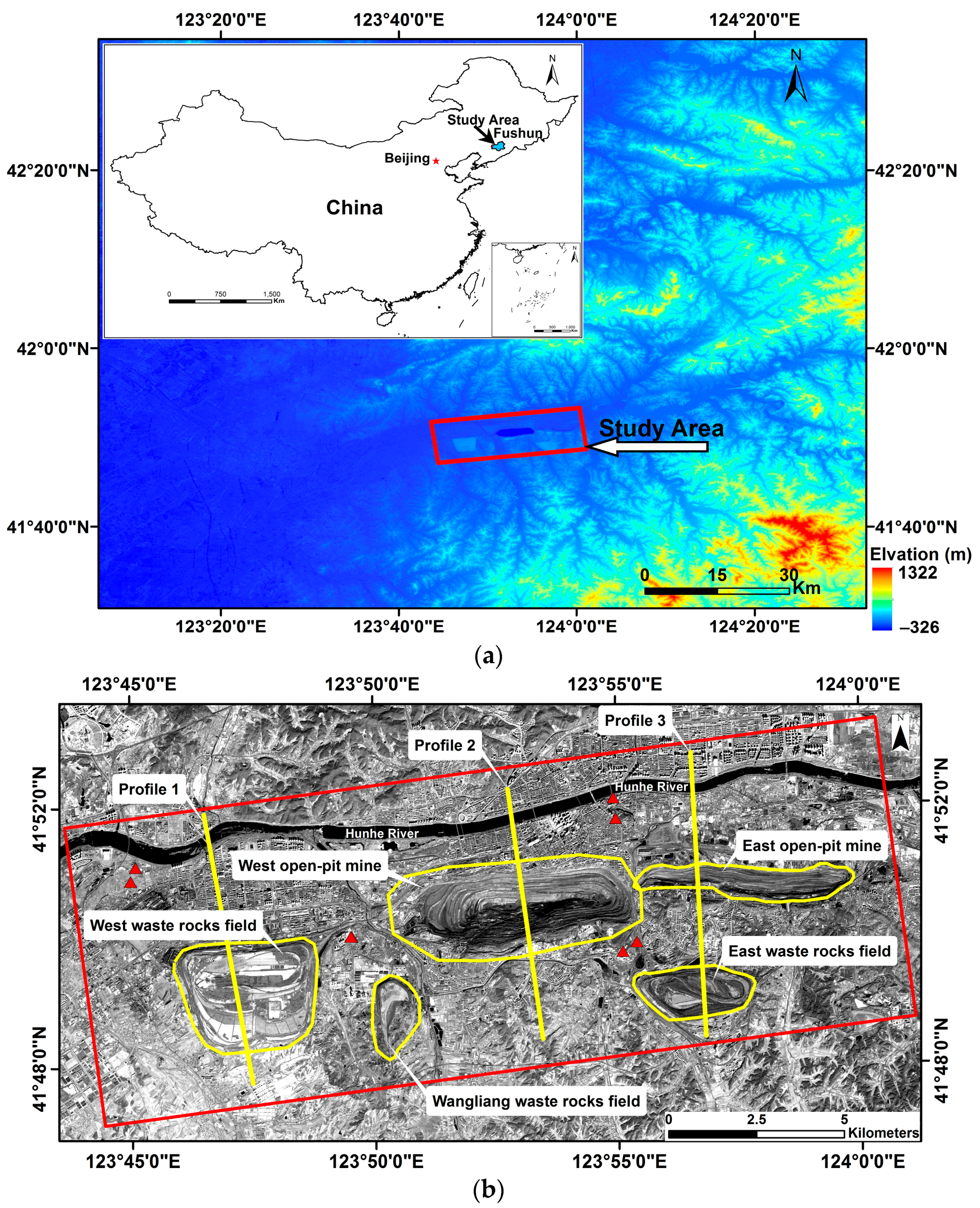
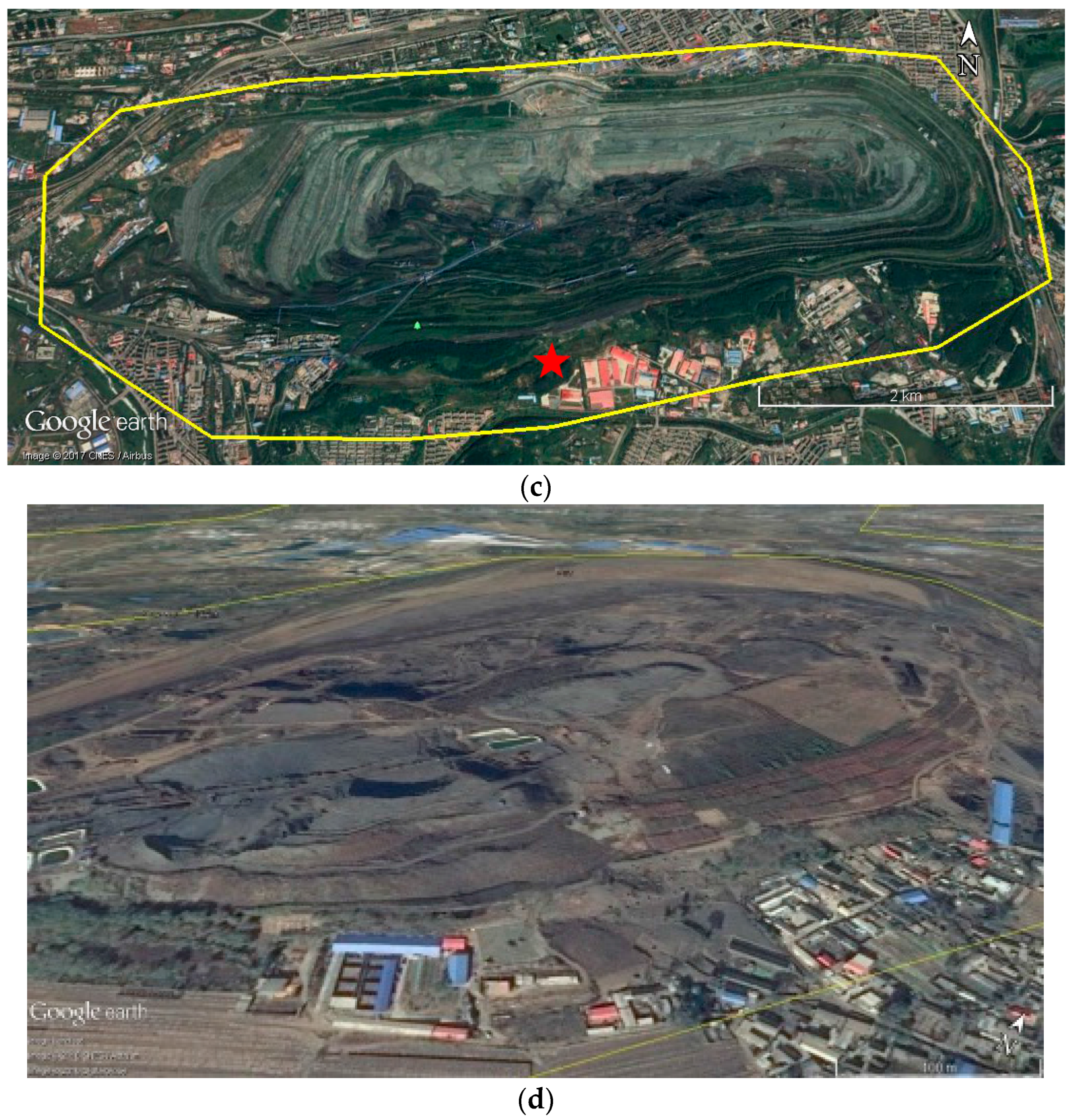
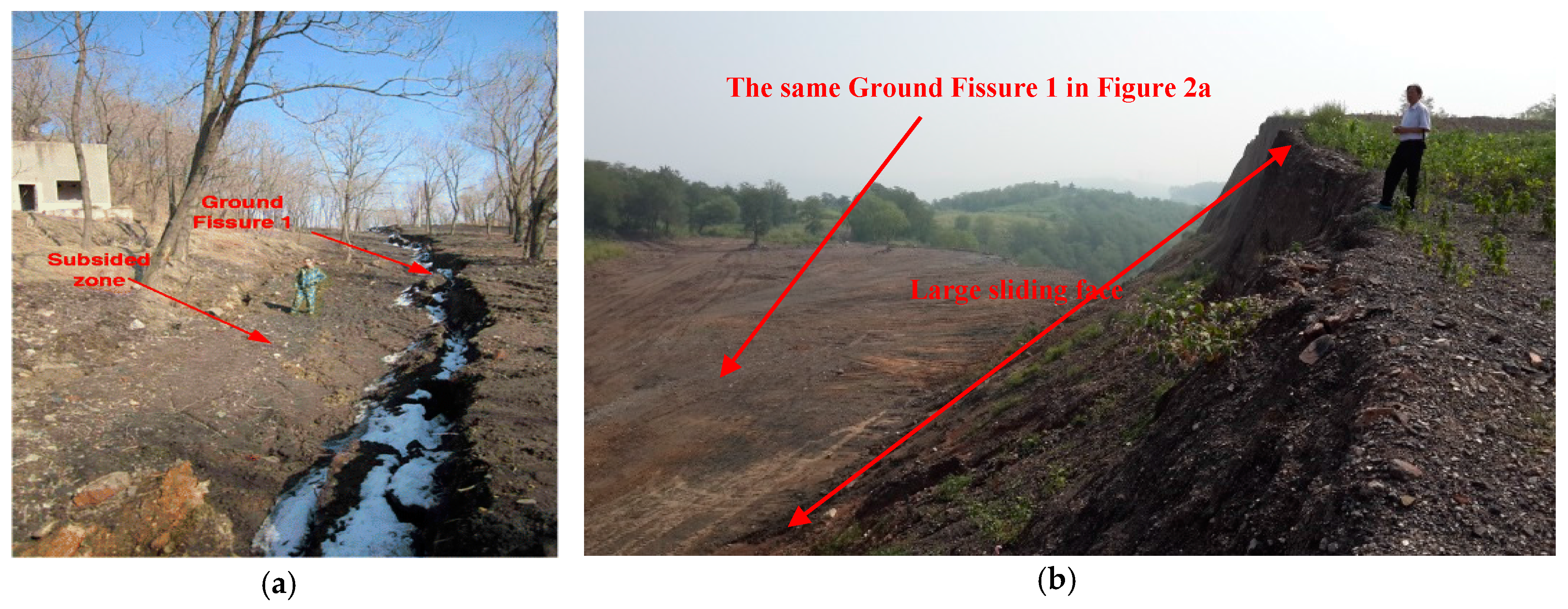
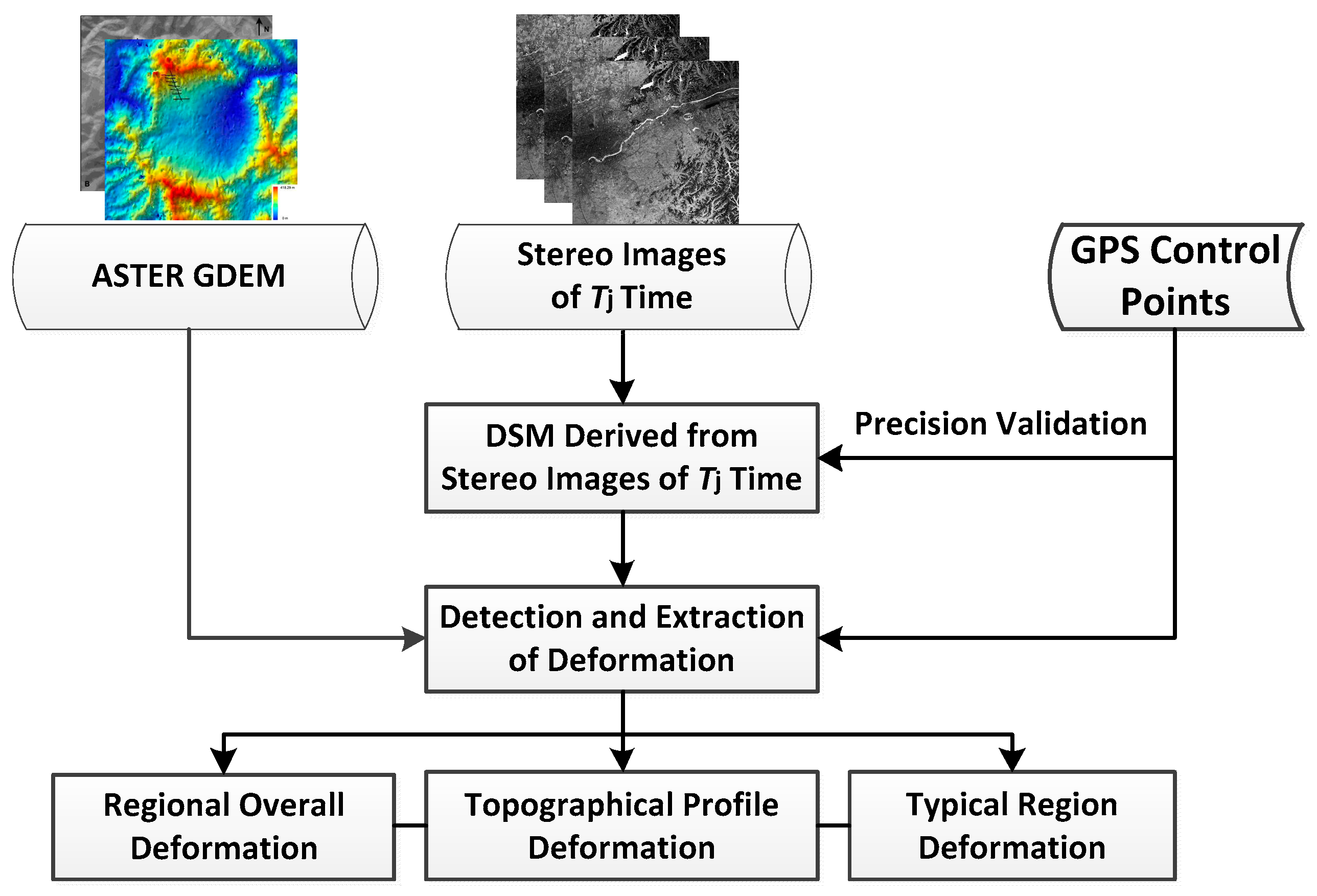
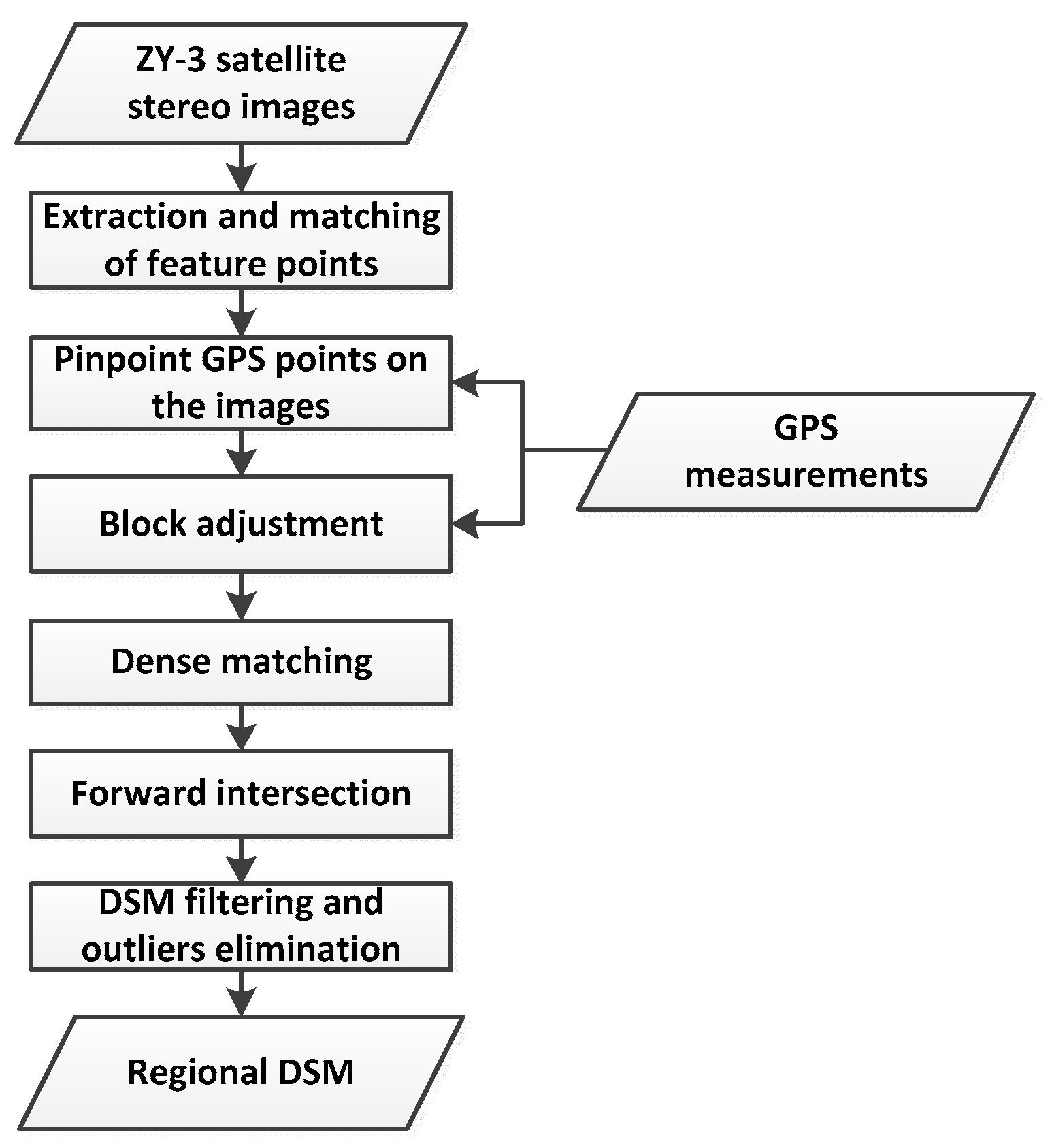
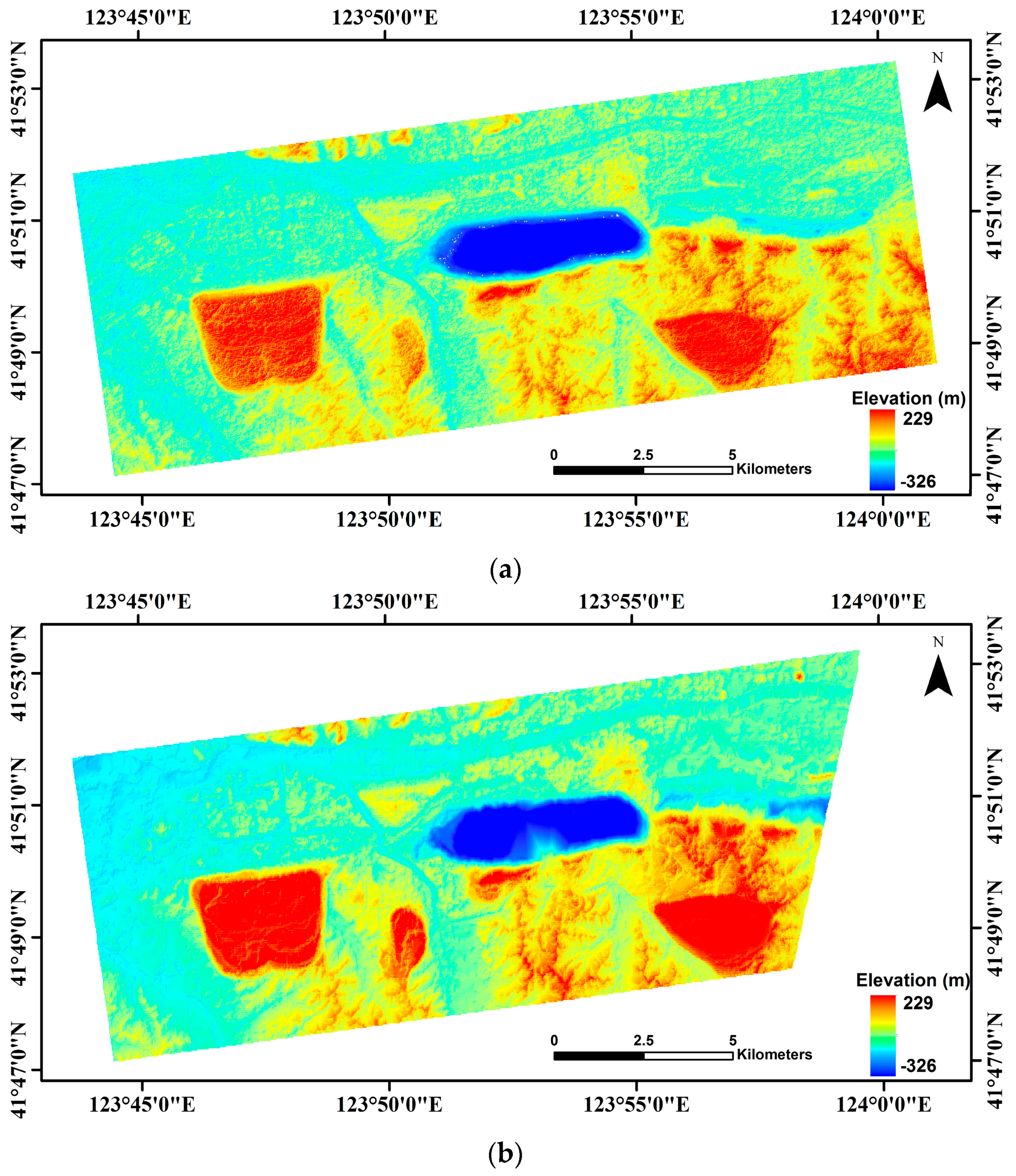
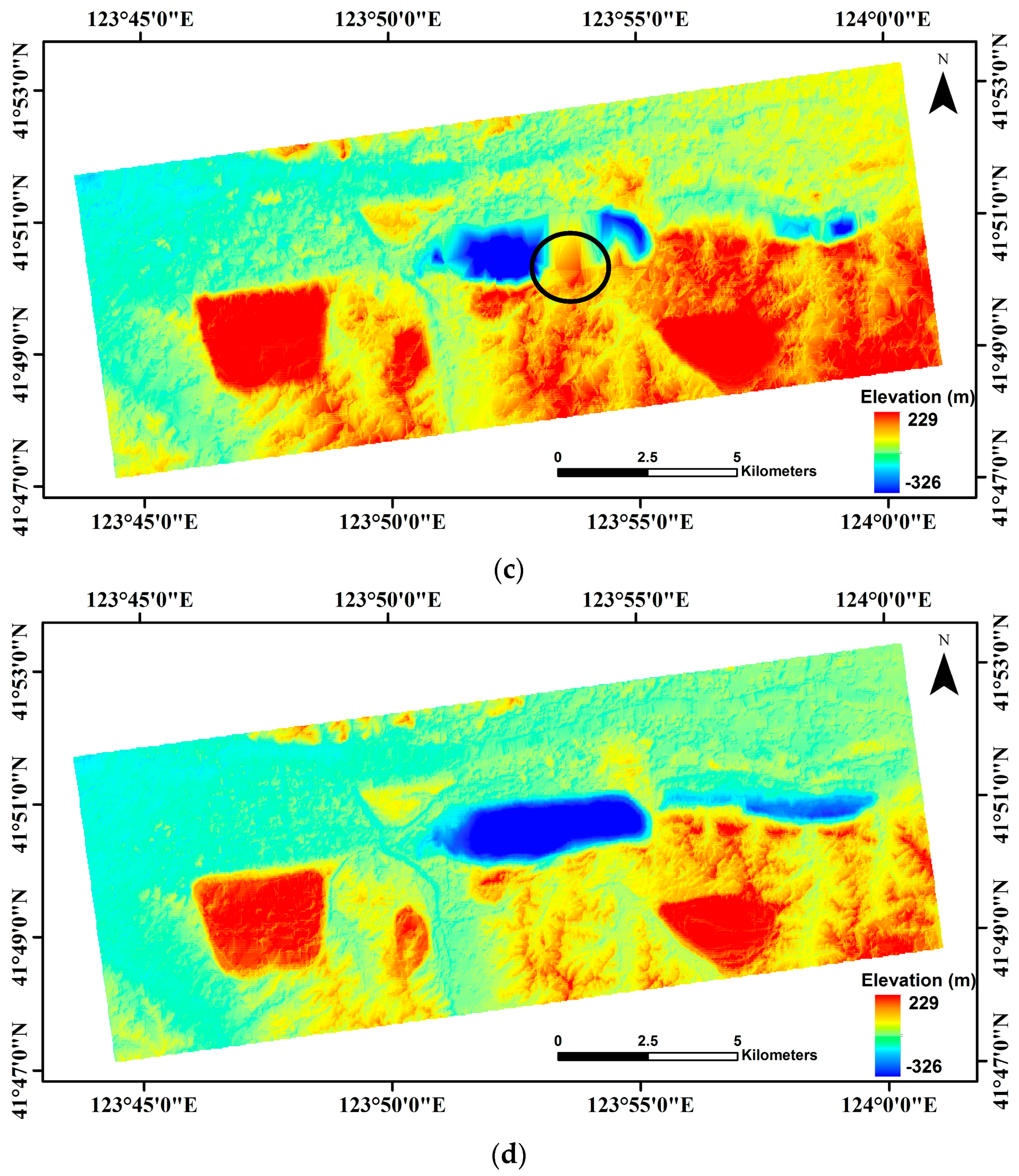
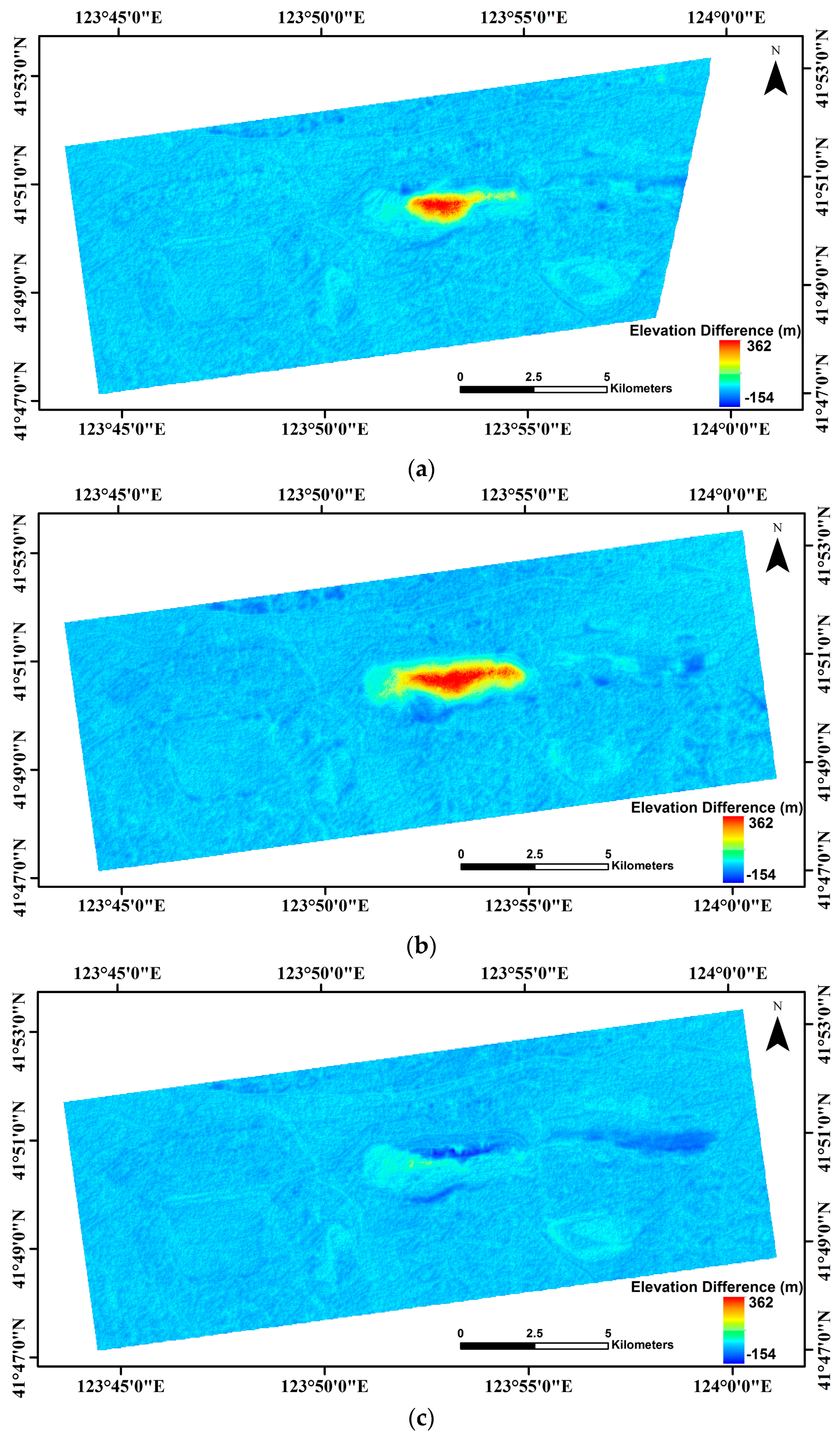
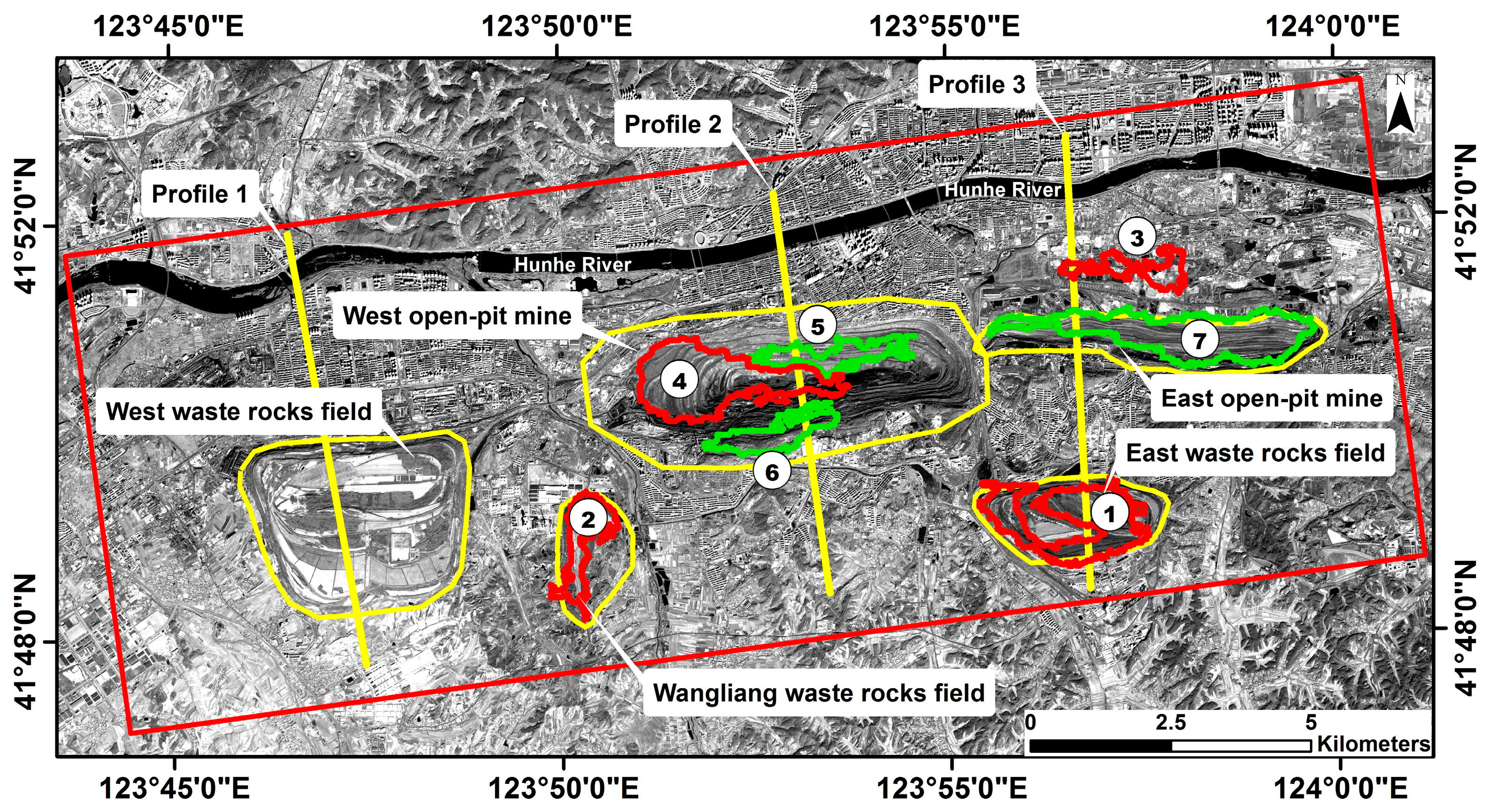
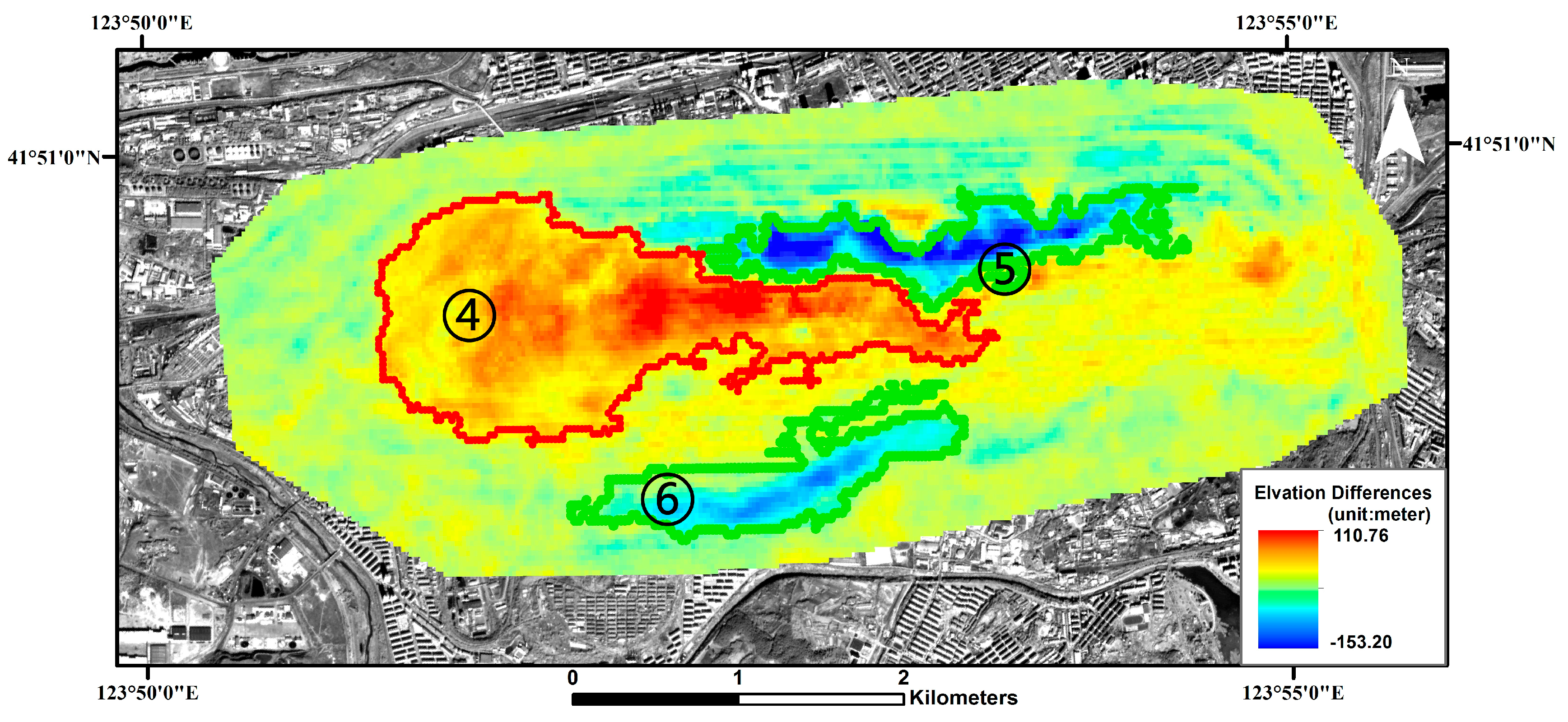
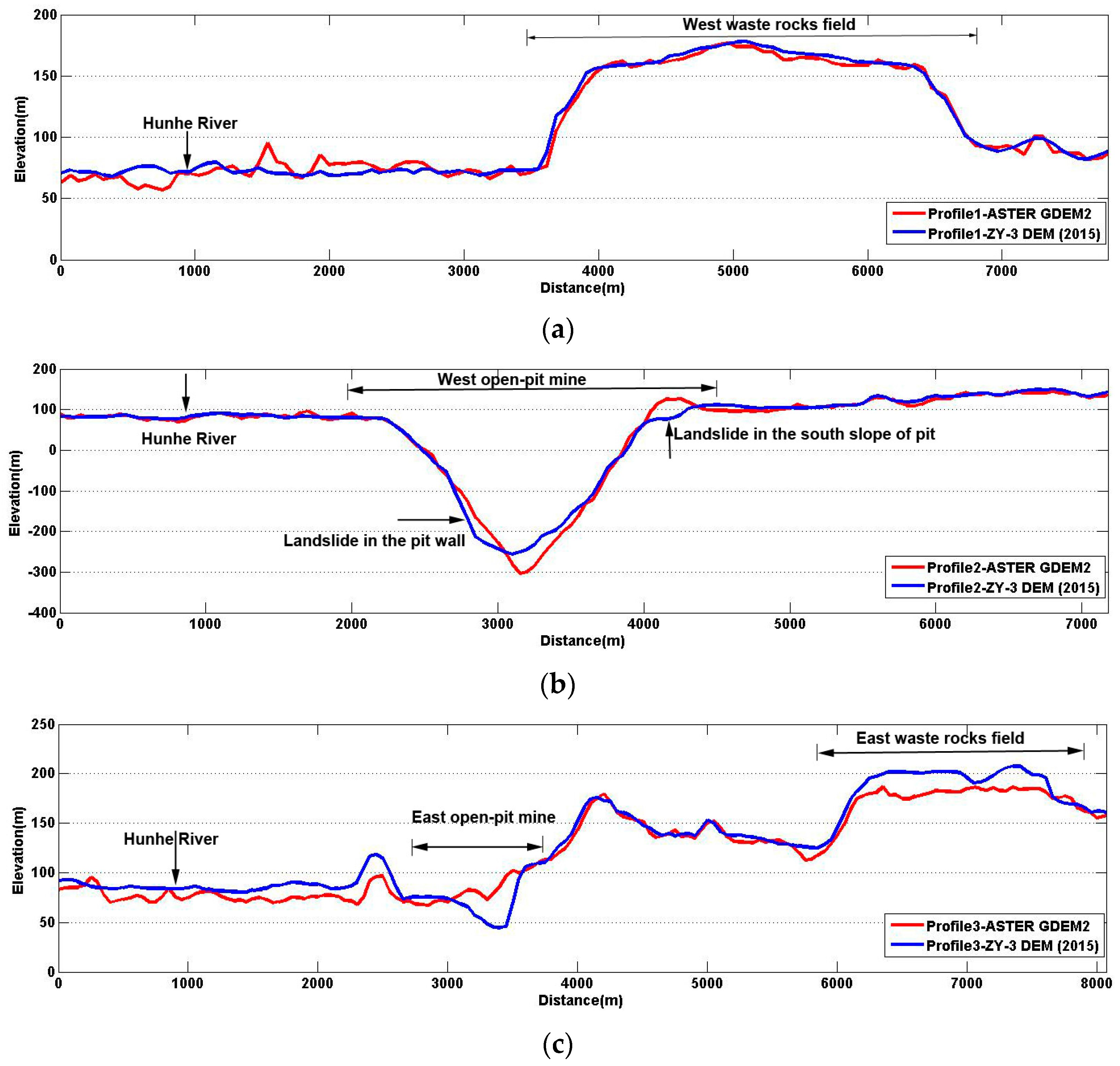
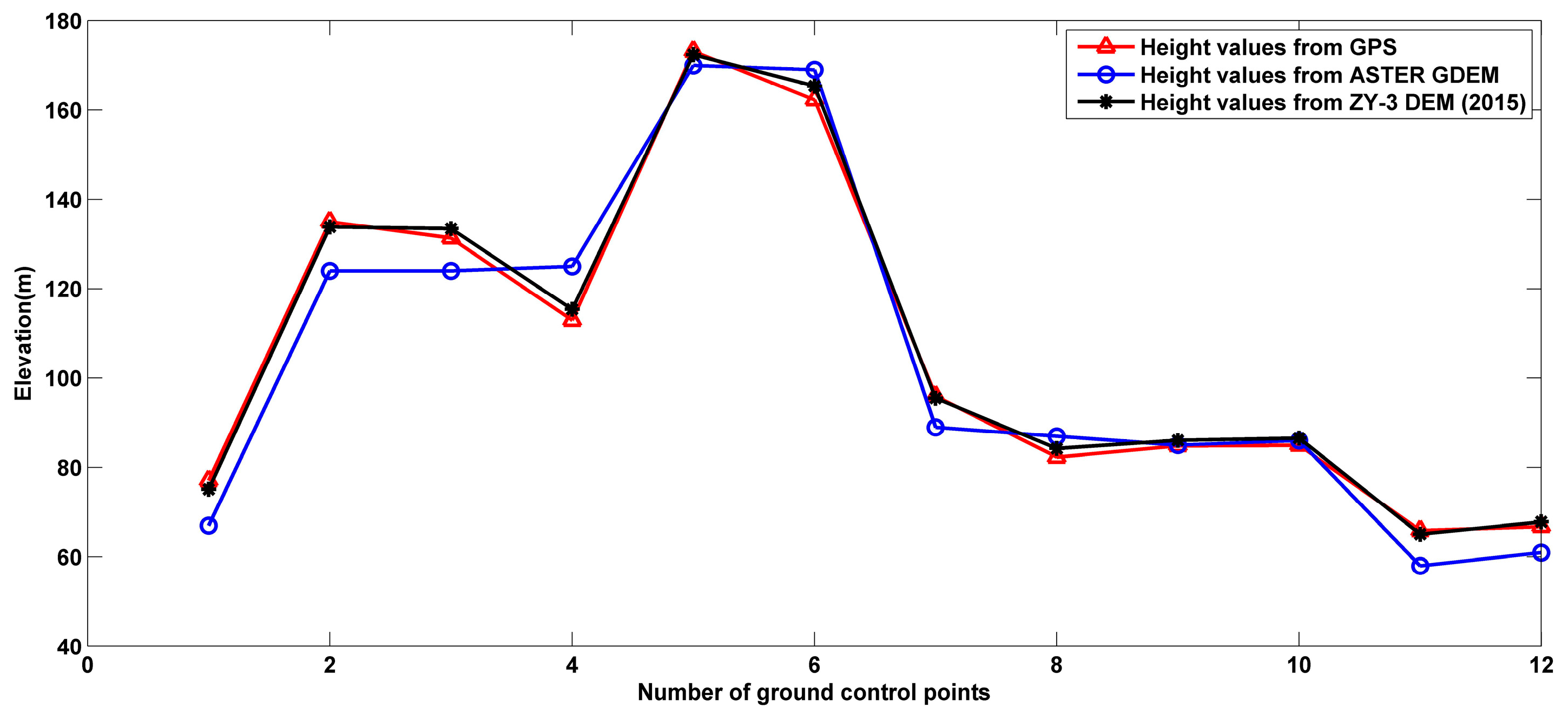
| Data Resource | Acquisition Time | DSM Spatial Resolution (m) |
|---|---|---|
| ZY-3 stereo images | 2013-12-24 | 10 |
| 2014-04-21 | 10 | |
| 2015-10-24 | 10 | |
| ASTER GDEM | 2010-7 | 30 |
| Time | Data Source | Minimum (m) | Maximum (m) | Mean (m) | Standard Deviation (m) | RMS (m) |
|---|---|---|---|---|---|---|
| 2010-07 | ASTER GDEM | −326.00 | 228.00 | 90.83 | 50.24 | 8.68 [40] |
| 2013-12-24 | ZY-3 DSM | −125.64 | 206.01 | 96.54 | 39.52 | 4.04 |
| 2014-04-21 | ZY-3 DSM | −97.97 | 202.33 | 97.41 | 33.71 | 2.11 |
| 2015-10-24 | ZY-3 DSM | −312.49 | 228.39 | 93.86 | 49.85 | 1.72 |
| Data Sets | Minimum (m) | Maximum (m) | Mean (m) | Standard Deviation (m) |
|---|---|---|---|---|
| 2013 ZY-3 DSM and ASTER GDEM | −75.25 | 338.58 | 8.38 | 23.63 |
| 2014 ZY-3 DSM and ASTER GDEM | −72.94 | 361.32 | 6.61 | 31.69 |
| 2015 ZY-3 DSM and ASTER GDEM | −153.20 | 110.76 | 3.12 | 11.18 |
| Range of Elevation Changes | Ratio | Range of Elevation Changes | Ratio |
|---|---|---|---|
| <−10 m | 5.85% | >10 m | 16.42% |
| −10 m~−3 m | 12.70% | 3 m~10 m | 36.21% |
| −3 m~0 m | 12.17% | 0 m~3 m | 16.65% |
| Total descending | 30.72% | Total rising | 69.28% |
| Name of Typical Regions | Parameters of Elevation Changes (m) | Area (km2) | Volume Change (m3) | |||
|---|---|---|---|---|---|---|
| Minimum | Maximum | Mean | Standard Deviation | |||
| 1.West open-pit mine | −153.20 | 110.76 | 5.56 | 25.53 | 17.08 | 9.50 × 107 |
| 2.East open-pit mine | −79.04 | 44.04 | −15.40 | 23.01 | 4.68 | −7.20 × 107 |
| 3.West waste rocks field | −26.60 | 32.42 | 3.33 | 5.99 | 10.96 | 3.65 × 107 |
| 4.East waste rocks field | −26.11 | 58.96 | 16.78 | 10.42 | 3.96 | 6.65 × 107 |
| 5.Wangliang waste rocks field | −21.20 | 43.78 | 10.81 | 11.09 | 2.38 | 2.57 × 107 |
| Districts with Obvious Elevation Changes | Elevation Increase (↑) or Decrease (↓) | Average of Elevation Change (m) | Area (km2) | Volume Change (m3) |
|---|---|---|---|---|
| ① In east waste rocks field | ↑ | 23.80 | 2.90 | 6.91 × 107 |
| ② In Wangliang waste rocks field | ↑ | 21.59 | 1.11 | 2.40 × 107 |
| ③ In the north of east open-pit mine | ↑ | 19.22 | 0.86 | 1.65 × 107 |
| ④ In west open-pit mine | ↑ | 36.35 | 3.57 | 1.37 × 108 |
| ⑤ In west open-pit mine | ↓ | −41.77 | 1.15 | −4.81 × 107 |
| ⑥ In west open-pit mine | ↓ | −28.66 | 1.10 | −3.14 × 107 |
| ⑦ In east open-pit mine | ↓ | −31.24 | 3.87 | −1.21 × 108 |
| Parameters | RMS |
|---|---|
| H (m) | 2.43 a |
| S (km2) | 0.00089 |
| V (m3) | 2.36 × 103 |
| Height Differences in GCPs | Minimum (m) | Maximum (m) | Mean (m) | Standard Deviation (m) |
|---|---|---|---|---|
| ASTER GDEM and GPS measurements | −11.01 | 12.05 | −2.29 | 7.27 |
| ZY-3 DSM (2015) and GPS measurements | −1.97 | 3.07 | 0.70 | 1.64 |
| ZY-3 DSM (2015) and ASTER GDEM | −9.62 | 9.84 | 2.99 | 6.07 |
© 2017 by the authors. Licensee MDPI, Basel, Switzerland. This article is an open access article distributed under the terms and conditions of the Creative Commons Attribution (CC BY) license (http://creativecommons.org/licenses/by/4.0/).
Share and Cite
Hu, W.; Wu, L.; Zhang, W.; Liu, B.; Xu, J. Ground Deformation Detection Using China’s ZY-3 Stereo Imagery in an Opencast Mining Area. ISPRS Int. J. Geo-Inf. 2017, 6, 361. https://doi.org/10.3390/ijgi6110361
Hu W, Wu L, Zhang W, Liu B, Xu J. Ground Deformation Detection Using China’s ZY-3 Stereo Imagery in an Opencast Mining Area. ISPRS International Journal of Geo-Information. 2017; 6(11):361. https://doi.org/10.3390/ijgi6110361
Chicago/Turabian StyleHu, Wenmin, Lixin Wu, Wei Zhang, Bin Liu, and Jiaxing Xu. 2017. "Ground Deformation Detection Using China’s ZY-3 Stereo Imagery in an Opencast Mining Area" ISPRS International Journal of Geo-Information 6, no. 11: 361. https://doi.org/10.3390/ijgi6110361





